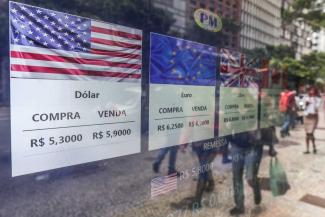Macroeconomics
The heavy burden of a strong dollar

Exchange rates have recently become increasingly volatile. In view of inflation, the Fed (Federal Reserve – the central bank of the USA) has adopted a hawkish policy, raising interest rates several times. The federal funds rate was close to zero at the start of the year and is now in the range of three to 3.25 %. For several reasons, this effort to control rising prices increases recession risks not only in the USA and may indeed lead to a global downturn.
The pandemic and the war have generally increased uncertainty. Investors have therefore become more risk averse. Moreover, higher interest rates make investments in the real economy, which are important drivers of growth, more expensive. The reason is that these investments are normally financed at least in part with loans. High interest rates therefore generally reduce growth. This mechanism applies to all economies, including the USA.
The big irony is that a central bank’s interest rates have only very little impact on energy and food prices, which are currently the main drivers of inflation. However, higher rates do make investments in clean energy more expensive, which would reduce the relevance of fossil-fuel imports and make economies more environmentally sustainable.
International implications
The Fed’s new stance has further impacts internationally. Higher interest rates in the USA are an incentive for international investors to seek the safe harbour afforded by the dollar. Accordingly, the exchange rate of the dollar keeps rising relative to the currencies of most economies. At the same time, the strong dollar tends to hurt particularly developing economies in several ways:
- Many of them – and especially the least developed countries – cannot borrow in their own currencies. They must service dollar-denominated loans in dollars. Servicing means paying back the loan plus the interest rate. As the dollar appreciates, their loans thus become more expensive measured in their national currencies. Sovereign debt burdens, which are already a huge problem in many countries, are becoming heavier.
- To keep their own currencies from depreciating, the central banks of other countries must follow the Fed’s example and raise interest rates. They are already quite high in many developing countries and emerging markets. While higher interest rates help to stem capital flight into safer financial assets in the USA, they make real-economy investments even less attractive.
- Should a dollar-denominated loan need to be refinanced, the new loan will not only come at a higher exchange rate but also at a higher interest rate.
The current situation is extremely challenging. On the one hand, central banks in developing countries want to encourage the inflow of foreign investment. On the other hand, rising interest rates increase the cost of domestic borrowing and have a stifling effect on growth. In the longer run, lower growth is also likely to undermine government revenues, further worsening debt problems.
Impacts on trade
The stronger dollar also has impacts on trade, especially since the US currency dominates international transactions. Even companies that operate in non-dollarised economies use it to settle deals. Commodities, in particular, are generally bought and sold in dollars everywhere, so countries that export commodities may actually benefit from the strong dollar to some extent.
Other countries, however, often see their exports increase too. The reason is that the high exchange rate of the dollar makes their goods comparatively cheap in the eyes of foreign buyers. On the downside, imports are becoming more expensive in terms of domestic currencies. That applies both to consumer goods – including food, which some countries depend on – and intermediate goods that are needed to produce other goods. As a result, domestic firms may be forced to reduce investments and/or output.
It matters very much that most developing economies are so-called “price-takers”. The term means that they are unable to influence world-market prices. As they depend on global trade, they are forced to sell their goods at whatever prices are currently paid. All told, while economies with strong export sectors may benefit from a strong dollar because it allows them to sell even more abroad, most economies suffer.
Exchange-rate volatility is a problem in itself
The high volatility of an exchange rate, moreover, is a problem in itself. Fast and unpredictable changes in external value of a currency contribute to the general sense of uncertainty. The fastest changing exchange rate this year so far was that of the Russian rouble (mostly because of the war), followed by the Turkish lira and the Brazilian real. Such volatility tends to be counterproductive for the real economy, because it causes abrupt reversals in capital flows and undermines planning. The threshold above which exchange-rate volatility starts to negatively affect the real economy is usually lower in small economies than in large ones.
Finally, excessive exchange-rate volatility has implications for monetary policy. It may make monetary policy ineffective, particularly when there are inconsistencies between the policies of the central banks and the ministers in charge of finance and economic affairs. Persistent central-bank interventions to stabilise exchange rates can incur high costs moreover. That can be the case in terms of dwindling foreign reserves and/or the central bank buying assets of dubious value.
Tougher times
The appreciating dollar is currently compounding economic problems in many places. The Fed’s new policy means tougher times for most disadvantaged nations. To a lesser, but nonetheless important extent, that applies to the European Central Bank (ECB) too, which is also, though more slowly, increasing its rates.
The central banks of high-income nations do not have a history of considering impacts on poorer world regions. People in developing countries and emerging markets are used to the pattern of established western powers appealing to the global common good when its suits them, but pursuing narrowly understood national interests when they can.
Unfortunately, developing countries have few options to deal with the challenges of exchange rate depreciation and volatility in the short term. These challenges are best addressed pre-emptively rather than reactively. Generally speaking, the governments of developing countries should only engage in sustainable borrowing and always ensure that they have a strong flow of domestic revenues.
Even in troubling times, however, policymakers must do their best to find ways to incentivise investments in order to boost economic growth at the same time as they must reduce fiscal pressures. The international community, in turn, must do more to accelerate debt restructuring, which will be crucial for putting developing countries back on a more sustainable fiscal path (see Kathrin Berensmann on www.dandc.eu).
André de Mello e Souza is an economist at Ipea (Instituto de Pesquisa Econômica Aplicada), a federal think tank in Brazil.
andre.demelloesouza@alumni.stanford.edu








